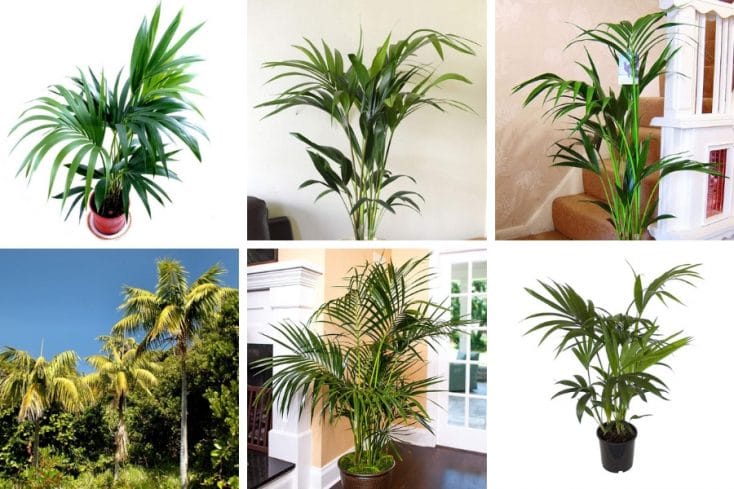Kentia palms, also called Paradise palms or Thatch palms, bring a wonderful, natural elegance to indoor locations. Given proper care, these palms are hardy and easy to maintain houseplants, adding a tropical appeal inside the home. Here’s a quick summary of how to care for kentia palm plants with more details outlined below.
How To Care For Kentia Palm (Howea forsteriana): Kentia palms perform best growing in well-drained soil, in a humid environment where temperatures range between 65°F (18°C) to 85°F (29°C). Water when the top three inches of soil become dry and fertilize monthly.
Keep reading because we take all the mystery out of caring for your Kentia palm and keeping it thriving for years to come.

How To Care For Kentia Palm
The slow-growing Kentia palm’s native range is Lord Howe Island located off the east coast of Australia. Kentia palms adapt well to outdoor growth, when planted in an environment that doesn’t experience winter freezes and the weather is consistently warm year-round.
However, its elegant beauty and durability to indoor growing conditions, has made the Kentia a popular palm for inside the home, especially in temperate climates where outdoor conditions are too cold for this tropical beauty.
Due to its elegant features, Kentia palms were a favorite of Queen Victoria and she added them as an addition to all her homes. It’s easy to see why this palm has been a favorite houseplant for centuries dressing up interiors from all economic standings, including the royals. The tall, thin, single trunks give way to feathery, green fronds that are smooth without any thorns or barbs.
Below we offer tips on properly caring for and growing this hardy indoor palm, as well as identifying and preventing potential problems before they occur.
Soil For Kentia Palms
In the Kentia’s native environment it grows and flourishes in sandy soil, which provides it with the
You can grow the palm in a mixture of straight potting mix, or other potting mixtures with good drainage. Although you can use potting soil, provided you add sand to decrease its heaviness and add the soil’s capability to drain, you don’t want to plant the palm in straight potting soil. Potting soil is usually too heavy, which means it has a tendency to retain too much moisture and can lead to problems with root rot.
You can easily make a soil mixture for your Kentia palm by mixing the following ingredients:
- Equal portions of potting soil and coarse sand
- Equal portions of coarse sand, peat and potting mix
Whatever you decide to use for your mix, making sure the soil mixture contains a bit of fertility promotes the best growth. Although the palm would grow for a time in straight sand, the soil doesn’t contain anything organic that feeds the root system.
Preferred Light Conditions
To keep the fronds producing green healthy growth, it’s necessary for the Kentia palm to receive some indoor light. However, the palm won’t tolerate a location situated in full sun, as the intense light burns the foliage.
Kentia palms will tolerate lower light conditions than many palms grown indoors. Although for the palm to produce the best growth, place in a location that received bright to medium, filtered light. If you desire to place it by a south-facing window, which is generally the sunniest window, make sure to filter the light by using something like a curtain.
In spring, and if you desire to let your Kentia palm soak up some of the goodness of being outdoors for a bit, make sure you situate it in a shadier location. If the outdoor light conditions are too bright, the foliage can end up burning, especially since the palm is accustom to indoor lighting.
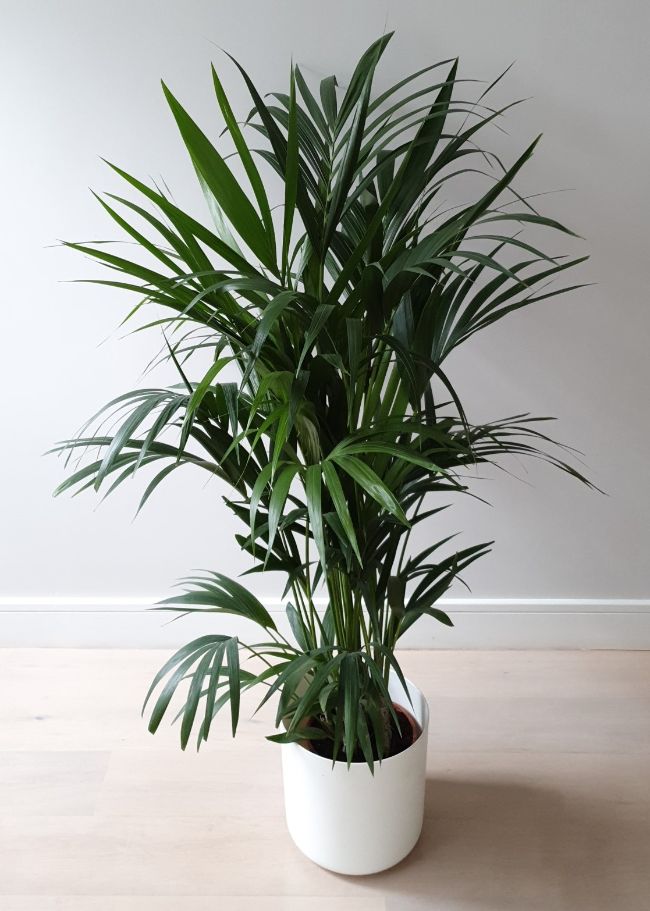
Indoor Temperature Requirements
In their native environment, Kentia palms thrive in consistently warm conditions. Its great ability to adjust to an indoor setting is one of the reasons it’s a popular, but sometimes expensive house palm. Indoors, the palm requires the same warm conditions it prefers for healthy growth as when grown outdoors in the garden. Prime indoor temperatures range between 65°F (18°C) to 85°F (29°C).
If you are growing a Kentia palm outdoors in a container, be sure to bring it indoors to a warm location before cold weather strikes in winter. Once the weather warms in spring, you can once again situate it back outdoors.
Watering Your Kentia Palm
Since consistently overwatering your Kentia palm can lead to root rot and its death, it’s best to follow some type of soil check and watering schedule to produce healthy growth and alleviate potential problems. Kentia palms have a moderate tolerance to drought conditions, so it’s better to miss a watering than overdo it and create soggy soil conditions.
However, the palm shows signs of problems with overwatering and underwatering as yellowing fronds that can or cannot have brown patches or tips. Checking the soil for dryness and only watering when needed usually cures the problem.
Knowing when to water your Kentia palm is relatively basic:
- Test the soil by sticking your fingers into it and if the top 3 inches are dry, it’s time to water.
- Apply water until it begins running out of the container’s bottom drain holes.
When it comes to what type of water to use, don’t use water that goes through a water softener because it contains too much salt. Kentia palms are sensitive to salty conditions. If your water contains an abundance of chemicals, let it set out overnight before using. You can also use rainwater or distilled water.
During the warmer months of spring throughout summer, you might have to water weekly. However, during winter when the palm is dormant and no longer actively putting on new growth, watering might be reduced to every couple of weeks.
Kentia Palm Humidity Needs
Tropical in nature, and like the vast majority of houseplants with a tropical home base, Kentia palms do best when residing in an indoor environment with humidity present. Don’t stress, because making your Kentia palm feel warm and cozy inside your house with adequate humidity is relatively easy and you have several options to fulfill its needs.
- Fill a spray bottle up with water and mist the Kentia palm’s fronds several times each week.
- Set the container on a larger, flat container that contains small rocks that catches all the water running out of the pot’s drain holes. As the water evaporates, it produces humidity.
- If your bathroom has enough natural light and is large enough to hold a potted palm, you can place the Kentia there. The constant use of water produces a humid environment for the palm.
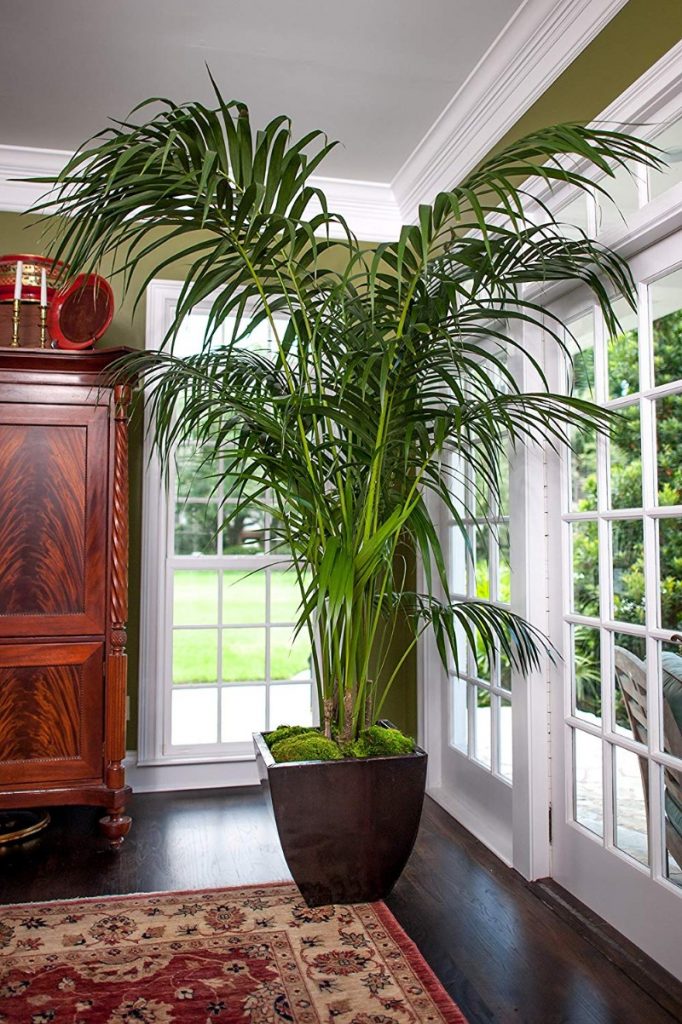
Fertilizer Needs
To keep your Kentia palm producing rich green fronds and happily growing, feed it monthly throughout the growing seasons of spring through summer. Cease all fertilizer applications during fall and winter, as the palm tree is in its dormant stage and stops putting on new growth.
You have several options when it comes to what and how to feed your Kentia palm:
- Use a water-soluble, houseplant blend applied at half-strength and applied monthly.
- Use an organic palm fertilizer blend applied at the recommended strength for container palms on the package. If no amount is listed, apply at half-strength. Dilute the mixture in water before applying to the container’s soil. Apply monthly.
- Use a slow-release fertilizer blend sprinkled over the top of the container’s soil. Slow-release fertilizers slowly break down with each water application and generally don’t require a repeat application for several months. Follow package directions on amounts and the frequency of its use.
Since the fertilizers can leave a buildup of salts in the Kentia palm’s soil, it’s best to flush the container’s soil with water every couple of months. This is as easy as taking the container outdoors and slowly running water from a hose through the soil for about five minutes. Allow the container to drain and bring the Kentia palm back indoors.
Pruning Requirements
Kentia palms have the same basic pruning requirements as other palms whether grown indoors or outside. Unless the frond is completely brown and dead, is in the way of something, or is damaged or diseased, it’s healthiest for the palm not to remove it until completely brown.
Even slightly brown Kentia fronds are still giving nourishment to the entire palm, so cutting off green or slightly green fronds remove these nutrients from the plant. Although having browning fronds on an indoor palm tree are unsightly, for the palm’s health benefit, allow them to stay on the tree until you just can’t stand the look anymore.
Depending on the size of the frond, you can snip them off using either hand pruner or loppers, cutting it off at the base of the palm.
To prevent the spread of pests of diseases to your Kentia palm, always make sure your pruning blades are clean and sterile before making your cuts. You can easily wipe the blades off with rubbing alcohol or another household disinfectant.
Potting and Repotting Kentia Palm
Depending on the size of your Kentia palm, using a 3-gallon container is usually sufficient for lush growth for several years. Although the palm is considered a slow-grower, if it becomes large, or too tall and top heavy, you may have repot into a 5-gallon container. When grown outdoors in a preferred environment, Kentia palms can grow up to 25 feet tall or taller and about half as wide. However, indoor Kentia palms usually top out around 5 or 10 feet tall.
When selecting a container for potting your Kentia, just make sure it has bottom drain holes. Any type of material works well, but those made of clay will have a tendency for the soil to dry out a bit faster than pots made out of plastic.
If you place the draining container inside of a decorative one without bottom hole, just be sure to empty any water that drains into it after each water application.
The only time you’ll need to repot your Kentia palm is if it’s grown too big for the present pot, or has depleted all the nutrients in the container’s soil. When potting or repotting, handle the sensitive root system very carefully and try not to damage it when removing from its present pot into the new one.
Kentia palms are happiest when their root systems are not disturbed and left all alone.
Just make sure you plant the Kentia is well-drained soil, the container drains and plant it no deeper than it was originally growing.
Propagating New Plants
Due to indoor conditions, Kentia palms will rarely bloom and produce seeds when grown indoors. The palm requires a bit of direct sunlight to start flowering and it only starts doing this when it reaches about 15-years-old. Once the seeds form, it can take three or four years for them to ripen and develop their deep red color.
However, if you are lucky enough to know someone with access to Kentia palm seeds, propagating them takes the same amount of patience as waiting for it bloom and bear seeds.
- Soak the red ripe fruits for three or four days in warm water. After that time, remove the seeds from inside the red exterior.
- Fill seed-starting trays or pots with a light, well-drained mix.
- Dust the Kentia seeds with a fungicide and then plant each seed shallowly in each pot.
- Water and keep the soil moist but not soggy.
- Place in a warm, partially sunny location.
Next, you just have to sit back and wait because it can take Kentia palm seeds anywhere from three months to three years to germinate.
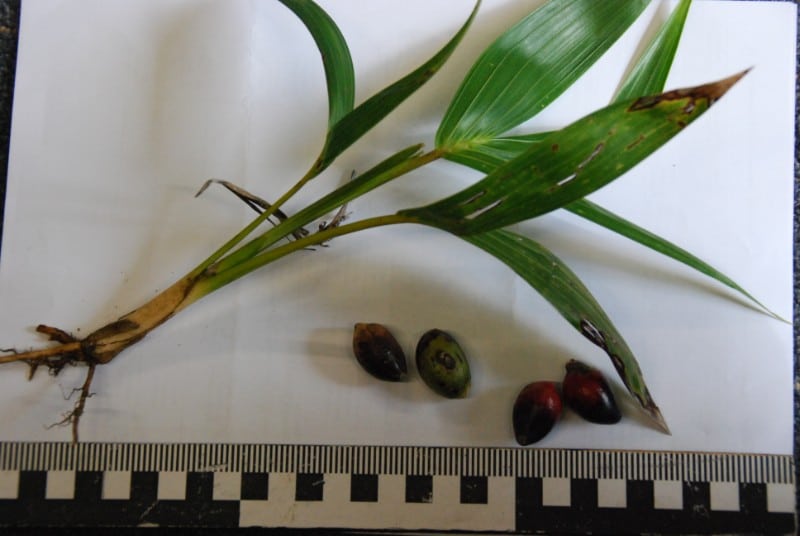
Pest And Disease Problems
When it comes to problems with disease, the biggest threat to indoor grown Kentia palms is root rot. Generally, this happens when the soil is too heavy, retaining too much moisture or the palm is overwatered on a regular basis and the soil never has a chance to dry out.
The best course of preventing problems with root rot are making sure the Kentia is growing in soil that drains well and watering only when the top three inches of soil becomes dry to the touch.
The two biggest threats from pests come from spider mites and mealy bugs and both are easily identified.
- Spider mites: Spider mites are tiny, white mites that suck the plant juices from the Kentia palm and if left unchecked, can kill the palm as well as infest your other houseplants. If you see fine, white webbing covering the fronds, you have a problem with spider mites.
- Mealybugs: Like spider mites, mealybugs suck the juices from the palm tree and can severely damage the palm as well as infest your other indoor plants. The insects leave cottony-like masses along the fronds.
If you catch the pest problem early, you might be able to wipe them off the Kentia palm with a damp cloth. However, if the infestation is starting to get large, you’ll have to call in the big guns. Saturating all the fronds with an insecticidal soap mixture or Neem oil usually controls the problem. Reapply as directed by the product you are using but it will generally require an additional application after one week.
Why Are The Leaves On My Kentia Palm Turning Brown?
Healthy and happy Kentia palm foliage is deep green, so browning foliage can be the result of several things. If the air is too dry and the palm isn’t getting adequate humidity, the foliage and tips can start browning. Browning foliage can also be the result of the palm not getting adequate water. In addition, too much fertilizer can also cause browning fronds and tips, as well as too much salt in the soil.
You can alleviate these problems by misting the palm regularly with water to increase humidity, and watering when the top three inches of soil become dry to the touch. Reduce fertilizer applications to half-strength and flush the soil of any salt buildup every couple of months using water.
How Often Do You Water A Kentia Palm?
During the seasons of spring throughout summer and while the Kentia palm is actively growing, you may need to water it every week. However, during winter while the palm is going through dormancy, you will probably only need to water every couple of weeks.
The best rule of thumb to follow on when to apply water is sticking your finger into the container’s soil and if the top three inches feel dry, water until it runs out of the bottom of the container.
Can Kentia Palms Take Full Sun?
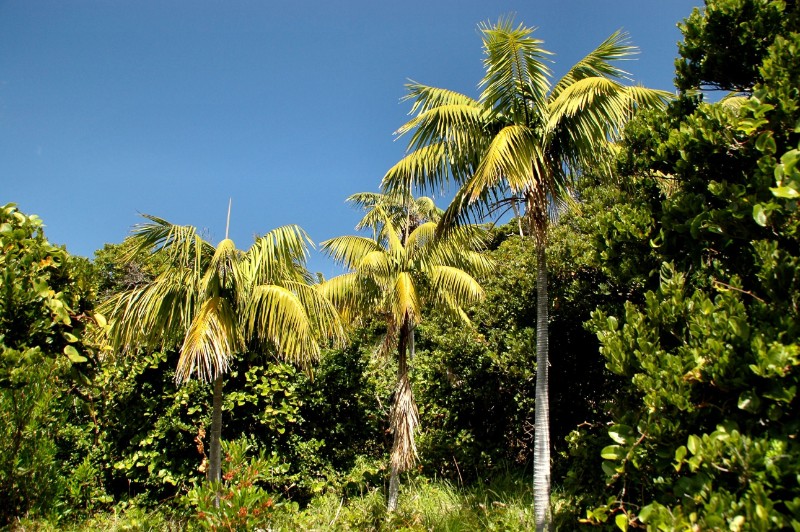
Kentia palms grown indoors won’t tolerate full sun, as this will cause sunburn to the foliage. When growing a Kentia palm indoors, it’s best to situate the tree in a location with bright to moderately bright, filtered sunlight.
If you move it outdoors during the warm seasons of the year to give it break from indoor growth, don’t place it in a location that receives more sunlight than what it was used to indoors. The direct rays of the sun can burn the foliage because the palm isn’t used to the intense sunlight. However, a Kentia palm that is around 5-years-old or older, can tolerate stronger sunlight than younger ones.
Interestingly, Kentia palms grown in their natural environment will tolerate very strong and direct sunlight. However, they are acclimatized to these conditions from the start of their growth. Indoor cultivated trees are used to lower light conditions, and it is the sudden change in intensity, which the plant cannot adapt to, that does the damage.
How Fast Does A Kentia Palm Grow?
One of the best aspects of growing a Kentia palm indoors is its natural slow-growth. Therefore, it usually takes well over five years for the palm grown indoors to reach its average indoor potential of around 5 to 10 feet tall.
Related Questions
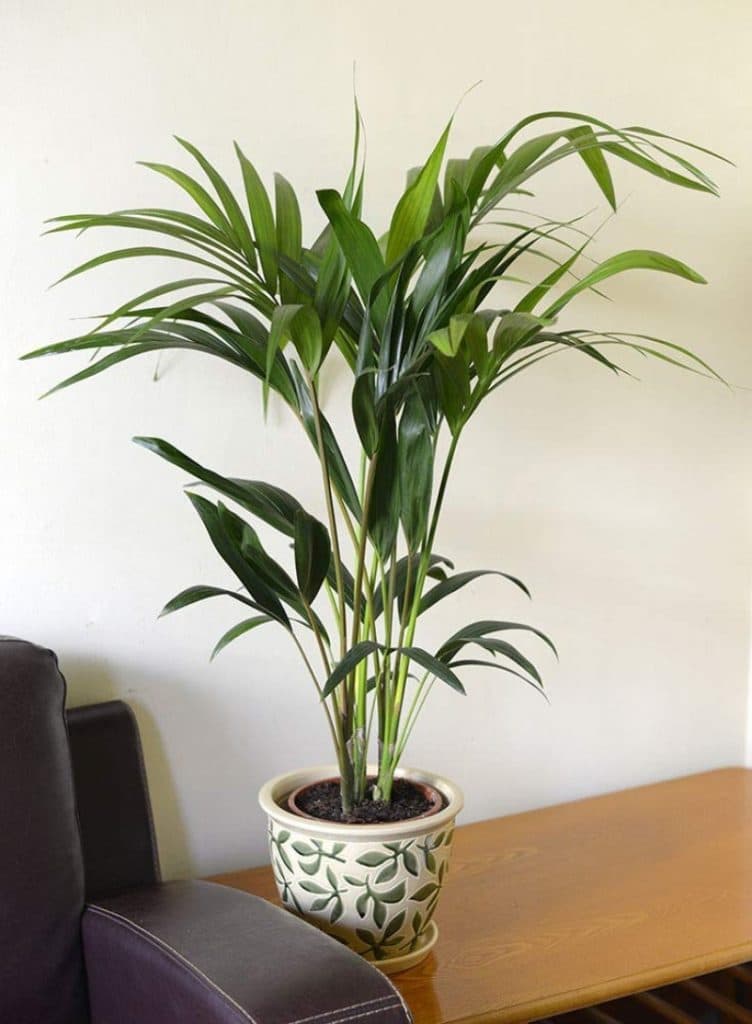
Are Kentia Palms Poisonous?
Kentia palms are entirely non-toxic to humans and pets, so you can safely place it anywhere in your house without concern.
What Type Of Flowers Do Kentia Palms Produce?
Kentia palms grown indoors rarely bloom due to the lack of sufficient light for flower production. However, grown outdoors, the white male and female blooms form on a 3-foot inflorescence, followed by egg-shaped fruits changing to red when fully ripe.
How Many Varieties Of Kentia Palms Are There?
Kentia palms consist of the most commonly found Howea
If you enjoy growing palms in your home, I have another really interesting article about Areca Palm Care. It’s another one of my favorite palms to grow indoors. Alternatively, check out my other articles about caring for your houseplants.
If you want to find out about some great resources that can help you look after your indoor plants, check out my recommended resources section. This will help you choose the best books, tools, and resources to help you develop your green thumb.

